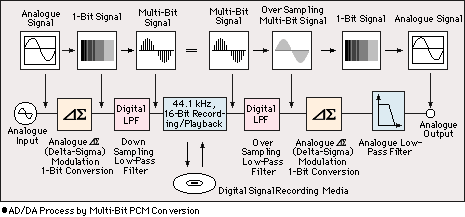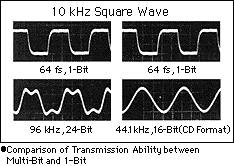|
|
||
|
|
||
 |
||
|
|
||
|
1-Bit Signals and PCM Multi-Bit Signals
|
||
|
|
||
|
||
|
|
||
|
This makes their characteristics similar to that of analogue signals. And while all digital signals need to be converted at the final stage into analogue signals to drive speakers, 1-bit signals, unlike multi-bit signals, do not require a D/A converter. They can be converted into analogue signals through a minimum process. To sum up, 1-bit signals with a simple conversion method modulate analogue signals onto the high frequency (64 fs) digital signals, remove digital signals in the high frequency range by a low-pass filter during playback, and then extract the original analogue signal without devices and circuits which tend to damage sound.
|
||
|
|
||
 |
||
|
|
||
| Even in the multi-bit processing, delta-sigma modulation is used during the conversion between analogue signals and PCM. An intermediate step in this interchange process generates a 1-bit signal which is closer to the original analogue signal than PCM. With 1-bit it is possible to faithfully record and store the original signal due to the fewer processes to pass through. The original analogue signal can then be reconstructed using only a simple low-pass filter circuit. Fluctuations and noise in the transmission path will not lead to signal deterioration as 1-bit signal is digital. As it obtains both high-fidelity and flexibility which multi-bit signals cannot achieve, Sharp focused on development of the high-sampling rate 1-bit signal to establish a technology that will find practical application in amplification circuits. | ||
|
|
||
 |
||
|
|
||
 |
||
|
|
||
|
|
||
|
|
||
|
|
||
